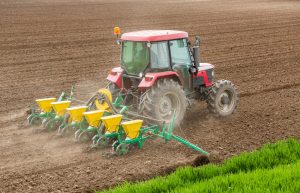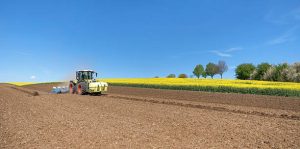Conservation agriculture is a farming approach that aims to increase crop yields while minimizing negative environmental impacts. This approach involves minimizing soil disturbance, maintaining soil cover, and crop rotation. The goal is to reduce soil erosion, water loss, and nutrient depletion while improving soil health and biodiversity. Conservation agriculture has gained popularity in recent years due to its potential to improve food security, reduce poverty, and promote sustainable development.

One of the key components of conservation agriculture is the use of improved seed drill techniques. Seed drills are machines that plant seeds at a precise depth and spacing, which can improve crop yields and reduce the amount of seed required. Advancements in seed drill technology have led to the development of no-till and minimum-till seed drills, which can reduce soil disturbance and improve soil health. These machines can also be used to plant cover crops, which can help to prevent soil erosion and improve soil fertility.
Key Takeaways
- Conservation agriculture is a farming approach that aims to increase crop yields while minimizing negative environmental impacts.
- Improved seed drill techniques are a key component of conservation agriculture, which can improve crop yields and reduce the amount of seed required.
- Advancements in seed drill technology have led to the development of no-till and minimum-till seed drills, which can reduce soil disturbance and improve soil health.
Principles of Conservation Agriculture
Conservation Agriculture (CA) is a sustainable agricultural production system that aims to improve soil health and productivity while reducing negative environmental impacts. It is based on three main principles: minimal soil disturbance, maintaining soil cover throughout the year, and improved crop rotations and diversity.
Soil Health and Management
The first principle of CA is minimal soil disturbance. This means that farmers avoid tillage as much as possible and use techniques such as no-till or reduced tillage. By reducing soil disturbance, farmers can preserve soil structure, improve soil water retention, and reduce soil erosion. This also helps to maintain soil health and fertility, which is essential for sustainable agriculture.
Crop Rotation and Diversity
Crop rotation and diversity is the second principle of CA. This involves growing different crops in sequence or association with each other. Crop rotation helps to break pest and disease cycles, improve soil health, and maintain soil fertility. Growing different crops also helps to increase biodiversity and reduce the risk of crop failure.
Minimal Soil Disturbance
The third principle of CA is maintaining soil cover throughout the year. This means keeping the soil covered with crops, crop residues, or other organic materials. This helps to reduce soil erosion, improve soil water retention, and increase soil organic matter. By maintaining soil cover, farmers can also reduce weed growth and improve soil temperature and nutrient availability.
Overall, the principles of CA aim to improve soil health and productivity, reduce negative environmental impacts, and promote sustainable agriculture. By adopting CA practices, farmers can improve their yields, reduce their costs, and contribute to a more sustainable future.
Advancements in Seed Drill Technology

Conservation agriculture has gained popularity in recent years due to its ability to reduce environmental degradation and increase soil health. One of the key components of conservation agriculture is the use of improved seed drill technology. This technology has undergone significant advancements in recent years, resulting in increased efficiency and effectiveness in planting crops.
Precision Seed Placement
One of the most significant advancements in seed drill technology is the ability to achieve precision seed placement. This is achieved through the use of advanced sensors and control systems that allow farmers to precisely place seeds at the desired depth and spacing. This technology ensures that seeds are planted at the optimal depth, which is crucial for proper germination and growth. Precision seed placement also ensures that seeds are spaced evenly, which reduces competition for resources among plants.
Reduced Soil Compaction
Another major advancement in seed drill technology is the ability to reduce soil compaction. Traditional seed drills often result in soil compaction due to the weight of the machinery and the depth of the seed placement. However, modern seed drills are designed to minimize soil compaction by using lighter machinery and shallower seed placement. This reduces soil compaction and improves soil health, which in turn results in healthier crops.
Enhanced Seed Germination
Improved seed drill technology has also resulted in enhanced seed germination. Modern seed drills are designed to place seeds at the optimal depth and spacing, which ensures that seeds have access to the nutrients they need to germinate and grow. Additionally, modern seed drills are designed to minimize seed damage during planting, which results in higher seed viability and germination rates.
In conclusion, advancements in seed drill technology have resulted in increased efficiency and effectiveness in planting crops. Precision seed placement, reduced soil compaction, and enhanced seed germination are just a few of the benefits of modern seed drill technology. These advancements have made conservation agriculture more accessible and effective, allowing farmers to produce healthier crops while minimizing environmental degradation.
Benefits of Conservation Agriculture

Conservation Agriculture (CA) is a farming system that promotes sustainable land use practices. It is based on the principles of minimal soil disturbance, maintaining soil cover throughout the year, and improved crop rotations. CA is a promising approach to sustainable agriculture that offers numerous benefits to farmers, the environment, and society at large.
Sustainable Yield Increases
One of the most significant benefits of CA is that it can lead to sustainable yield increases. By reducing soil erosion and improving soil health, CA can help to improve crop yields over time. Studies have shown that CA can increase crop yields by up to 50% compared to conventional tillage methods. This increase in yield can help to ensure food security for communities and improve the livelihoods of farmers.
Climate Resilience
Another benefit of CA is that it can help to build climate resilience. CA practices, such as crop rotation and the use of cover crops, can help to improve soil health and reduce soil erosion. This can help to mitigate the impacts of climate change, such as droughts and floods, by increasing the soil’s ability to retain water and nutrients. Additionally, CA can help to reduce greenhouse gas emissions by sequestering carbon in the soil.
Biodiversity Preservation
CA can help to preserve biodiversity. By reducing the use of synthetic fertilizers and pesticides, CA can help to promote a healthy soil ecosystem. This can lead to increased biodiversity, including beneficial insects and microorganisms, which can help to improve soil health and reduce the need for chemical inputs. Additionally, CA can help to preserve natural habitats and promote agroecosystem diversity.
In summary, Conservation Agriculture offers numerous benefits to farmers, the environment, and society. By promoting sustainable land use practices, CA can lead to sustainable yield increases, build climate resilience, and preserve biodiversity.
Implementation Strategies

Conservation agriculture and improved seed drill techniques are essential for sustainable agriculture. However, their implementation requires a comprehensive approach that includes farmer education and training, policy support and incentives, and community engagement.
Farmer Education and Training
Farmers need to be educated and trained on the benefits of conservation agriculture and improved seed drill techniques. They must understand the importance of reducing soil disturbance, retaining crop residues, and managing pests, weeds, and soil fertility. Training programs should be designed to meet the specific needs of farmers, taking into account their level of knowledge and experience.
Policy Support and Incentives
Governments can play a crucial role in promoting conservation agriculture and improved seed drill techniques by providing policy support and incentives. Policies should be developed to encourage farmers to adopt these techniques, including subsidies for the purchase of conservation agricultural equipment and tax incentives for the use of improved seed drills. Governments can also provide technical support and extension services to farmers to help them implement these techniques effectively.
Community Engagement
Community engagement is essential for the successful implementation of conservation agriculture and improved seed drill techniques. Farmers should be encouraged to work together to share knowledge and experience. Community-based organizations can also play a role in promoting these techniques and providing support to farmers.
In conclusion, the implementation of conservation agriculture and improved seed drill techniques requires a comprehensive approach that includes farmer education and training, policy support and incentives, and community engagement. By adopting these strategies, farmers can improve their yields, reduce soil degradation, and contribute to sustainable agriculture.
Challenges and Considerations

Adoption Barriers
Despite the potential benefits of conservation agriculture techniques and improved seed drill technologies, adoption rates remain low in many regions. One major barrier to adoption is the lack of knowledge and awareness among farmers. Many farmers are not familiar with these techniques and may be resistant to changing their traditional farming practices.
Another barrier to adoption is the cost of implementing these techniques. For example, purchasing a new seed drill can be expensive for small-scale farmers. Additionally, the initial transition to conservation agriculture may require more labor and time than traditional methods, which may be a deterrent for some farmers.
Economic Impacts
The economic impacts of conservation agriculture and improved seed drill techniques are complex and multifaceted. While these techniques can lead to increased yields and reduced labor costs in the long run, the initial investment required can be a significant burden for some farmers. Additionally, some farmers may be hesitant to adopt these techniques due to concerns about potential yield losses during the transition period.
Furthermore, the economic benefits of conservation agriculture may not be immediately apparent to farmers, particularly in the short term. This can make it difficult to convince farmers to invest in these techniques, as they may be more concerned with immediate financial returns.
Technological Limitations
While improved seed drill technologies have the potential to greatly improve the efficiency and effectiveness of conservation agriculture, some technological limitations must be addressed. For example, many small-scale farmers may not have access to the necessary equipment or technical expertise to properly use these technologies.
, there may be challenges related to the specific crops and growing conditions in different regions. For example, some crops may require specialized seed drills or other equipment that may not be readily available or affordable for all farmers.
Overall, while conservation agriculture and improved seed drill technologies offer many potential benefits, several challenges and considerations must be taken into account to successfully implement these techniques on a wider scale.
Frequently Asked Questions
What are the primary benefits of implementing conservation tillage practices?
Conservation tillage practices offer several benefits to farmers and the environment. By reducing soil disturbance, conservation tillage practices help to preserve soil structure and prevent erosion. This can lead to improved soil health, which in turn can lead to better crop yields. conservation tillage practices can help to reduce the amount of fuel and labor required for planting and other farm operations.
How does the use of a seed drill enhance agricultural efficiency?
Seed drills are an important tool for farmers looking to improve their planting efficiency. By allowing farmers to plant seeds at a consistent depth and spacing, seed drills can help to ensure that crops grow evenly and produce high yields. Additionally, seed drills can help to reduce the amount of seed wasted during planting, which can lead to significant cost savings over time.
What are the potential drawbacks associated with conservation agriculture?
While conservation agriculture practices offer many benefits, there are also some potential drawbacks to consider. For example, reduced tillage can lead to an increase in weed pressure, which may require additional weed control measures. Additionally, reduced tillage can lead to an increase in soil compaction, which can make it more difficult for roots to penetrate the soil and access nutrients.
In what ways does conservation agriculture contribute to soil health?
Conservation agriculture practices can contribute to soil health in several ways. By reducing soil disturbance, conservation agriculture practices help to preserve soil structure and prevent erosion. This can lead to improved soil health, which in turn can lead to better crop yields. conservation agriculture practices can help to increase the amount of organic matter in the soil, which can improve soil fertility and water retention.
Can you outline the main objectives that conservation agriculture aims to achieve?
Conservation agriculture aims to achieve several key objectives, including reducing soil erosion, improving soil health, and increasing crop yields. By reducing soil disturbance and promoting the use of cover crops, conservation agriculture practices can help to achieve these objectives while also reducing the environmental impact of agriculture.
What innovations in seed drill technology have significantly improved planting methods?
In recent years, several innovations in seed drill technology have significantly improved planting methods. For example, the development of no-till seed drills has allowed farmers to plant crops without disturbing the soil, which can help to preserve soil structure and improve soil health. , the use of GPS technology in seed drills has allowed farmers to plant crops with greater precision, which can lead to higher yields and reduced input costs.




